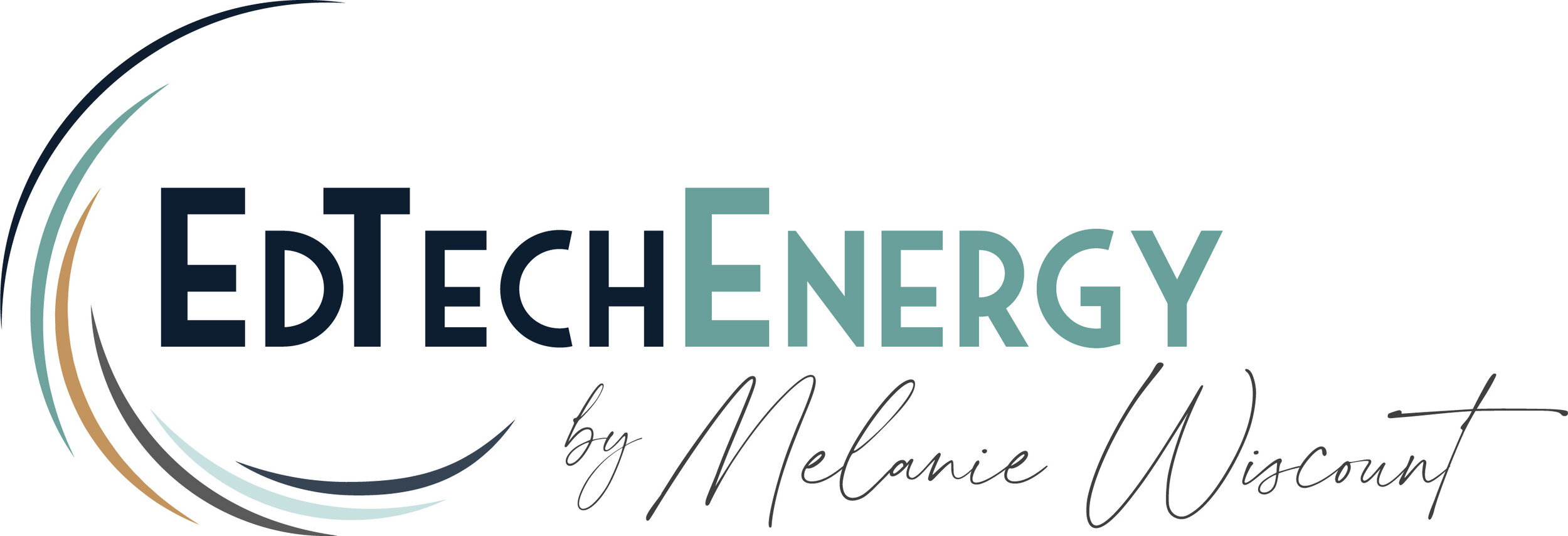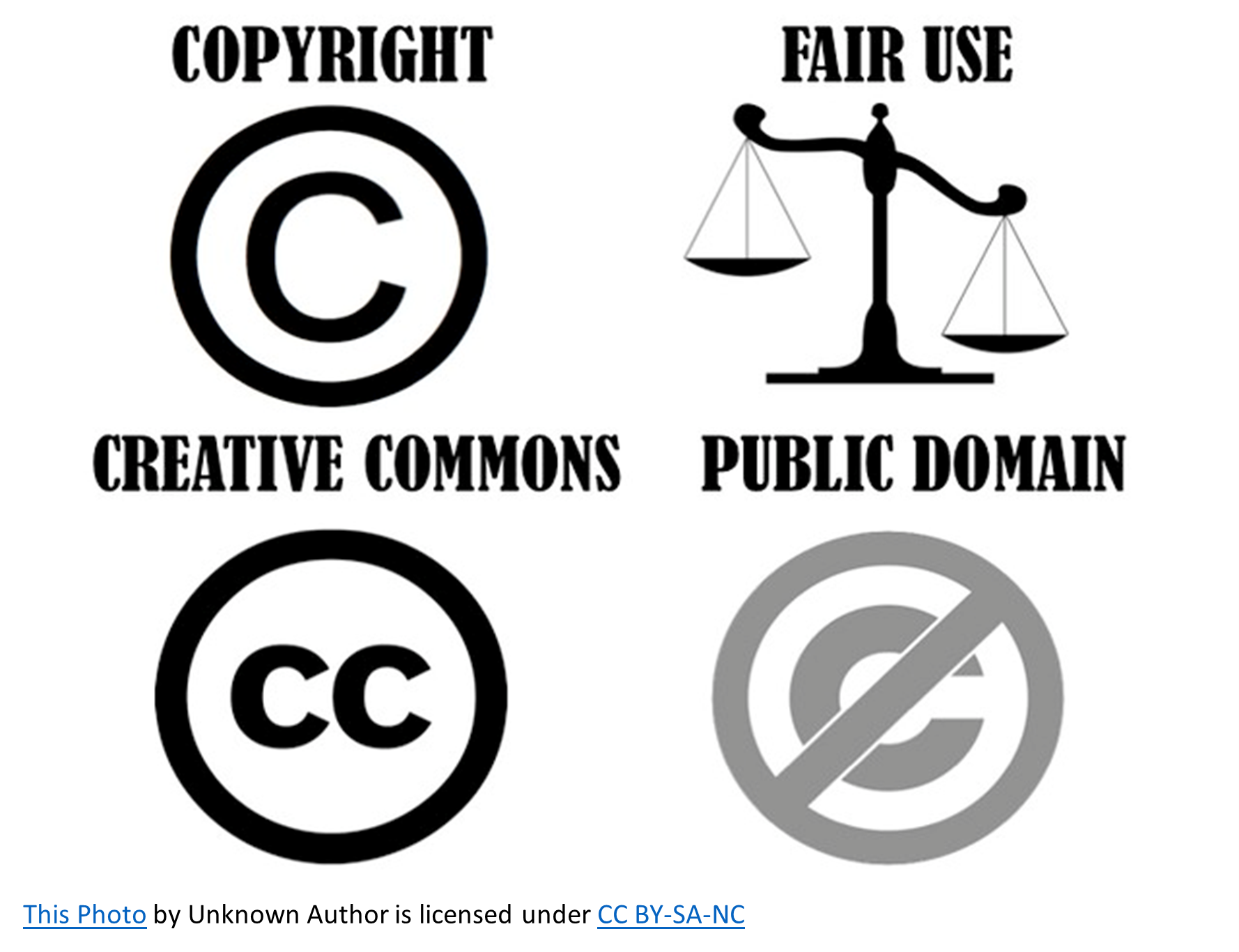Be on Top of Copyright, Fair Use, Creative Commons, and Public Domain in your Classroom
This Photo by Unknown Author is licensed under CC BY-SA-NC
~ estimated 13-minute read ~
I believe I attribute my prioritized focus on copyright, fair use, Creative Commons, and Public Domain in my instruction, student learning, and assessment to my 20 years’ experience in the business sector. In business, there were no juggling the do’s and don’ts of copyright, unless you wanted to be liable for copyright infringement. In sales, promotions, and marketing, as you can assume, it is serious stuff!
We can, in our classroom, make this a customary practice and develop a conscientiousness in our students about copyright, intellectual property, and checking licenses of media to make sure we can use them in our instruction, student learning, and their assessment.
Teaching Copyright, Fair Use, Creative Commons, and Public Domain is usually one of the first lessons I teach at the high school, professional development, and graduate levels. I like to present the guidelines we need to abide by and practice right from the start when we are using media to create and showcase information in different media forms.
For example, if one of your projects that you assign is for your students to create a video to showcase their understanding of a concept or skill, they should know that they cannot add any picture they found on Google in their assessment submission. The same is true for the college students I teach at the master’s and doctoral levels. Starting out teaching my students who are usually teachers, instructional coaches, EdTech coaches, or administrators sets them up for success (and no embarrassment) when I begin the course with a lesson about copyright, copyright infringement, and where Fair Use, Creative Commons, and Public Domain can be our solutions around finding and using media in ethical and legal ways.
When I taught computer science courses at the high school level, my junior students gained experience in a computer science summer internship in DC. When I received feedback from the interns’ mentors that my students taught the other interns how to search and use copyright-free media, I felt a lot of gratification. Setting my students up for success in the real world is another reason teaching students about copyright, copyright infringement, Creative Commons, and Public Domain is important in both school and outside of school situations students many times find themselves in whether it is an internship, parttime job, higher education, or in the workplace after graduation.
All you must do is search for “school copyright infringement” and you will find this is a real problem for adults in schools to follow copyright law when it comes to texts, printing, pictures, and music published online or printed for the classroom. One such case that got much attention a few years ago was when a Houston School District was ordered to pay $9.2 million dollars in a copyright infringement case to a small company called, Dynastudy, that prints study guides for students. As per this article, the principal purchased some copies of the study guides but then printed more for distribution to students. Even though the words, “Copying this material is strictly prohibited.” was on the study guide print, this guideline was not followed and copying the material was done.
Here is a link to one article about this case of copyright infringement by a school: https://abovethelaw.com/2019/06/houston-school-district-ordered-to-pay-9-2-million-in-copyright-infringement-case/
One fact schools and teachers must remember: parents because of their jobs know copyright law well. If a school, administrator, or teacher violates copyright law, many times it is a parent who reports the crime. And yes, copyright infringement is a crime under United States Copyright law and is a law protecting intellectual property rights.
I used to hang the Fair Use Policy by the printer in the copy room where I taught and many times, I heard my co-teachers complain about the limitations of what they were legally allowed to print according to Fair Use. Here is the Copyright and Fair Use Guidelines for Teachers poster I liked to post since it was easy to understand.
The four factors of Fair Use are the following:
Purpose and character of the use
Nature of the copyrighted work
Amount and substantiality of the portion used in relation to the copyrighted work as a whole
Effect of the use upon the potential market for or value of the copyrighted work
You can find more information on each factor at the U.S. Copyright website at https://www.copyright.gov/fair-use/more-info.html.
Some of the limitations on this poster that frequently got my teacher colleagues’ attention were:
Print media: Only one copy allowed per student (which meant, no “extras”).
Music media: A maximum of 30 seconds per musical composition may be used.
Video media: Students “may use portions of lawfully acquired copyright works in their academic multimedia,” defined as 10 percent or three minutes, whichever length was less.
To begin, let us define the four major media licenses you and your students should know:
Copyright – “Copyright, a form of intellectual property law, protects original works of authorship including literary, dramatic, musical, and artistic works, such as poetry, novels, movies, songs, computer software, and architecture.”
Source: https://www.copyright.gov/
Copyright infringement – “copyright infringement occurs when a copyrighted work is reproduced, distributed, performed, publicly displayed, or made into a derivative work without the permission of the copyright owner.”
Source: https://www.copyright.gov/help/faq/faq-definitions.html
Fair Use – “a legal doctrine that promotes freedom of expression by permitting the unlicensed use of copyright-protected works in certain circumstances.”
Source: https://www.copyright.gov/fair-use/more-info.html
Creative Commons – “a set of various licenses that allow people to share their copyrighted work to be copied, edited, built upon, etc., while retaining the copyright to the original work.”
Source: https://www.dictionary.com/browse/creative-commons
CC-BY – provide attribution
CC-BY-SA - provide attribution and share alike with same CC license
CC-BY-NC - provide attribution and cannot be used for commercial purposes
CC-BY-ND - provide attribution and cannot revise, edit, or adapt the media
CC-BY-NC-ND - provide attribution, cannot be used for commercial purposes, and cannot revise, edit, or adapt the media
CC0 – (choose zero) CC0 licenses allow copyright owners to release their works without restriction. It is a Creative Commons license.
Source: https://creativecommons.org/about/cclicenses/
Public Domain – “A work of authorship is in the “public domain” if it is no longer under copyright protection or if it failed to meet the requirements for copyright protection. Works in the public domain may be used freely without the permission of the former copyright owner.”
Source: https://www.copyright.gov/help/faq/faq-definitions.html
There are many different lessons online that you can share with your students to learn about copyright, Fair Use, Creative Commons, and Public Domain. Below are some of my favorites that students and adult learners also learn and enjoy:
For students:
https://www.copyright.gov/history/Copyright_For_Kids.pdf (MS)
https://learn.teachingchannel.com/video/teaching-students-copyright (HS)
http://www.copyrightkids.org/ (ES & MS)
https://www.copyrightandcreativity.org/ (ES, MS, HS)
https://www.youtube.com/watch?v=h7QmSKHCQoY&t=77s or https://video.link/w/JIJFc (MS & HS)
https://www.youtube.com/watch?v=XzzkSZ0Jrko&t=10s or https://video.link/w/vLJFc (HS)
https://creativecommons.org/about/videos/ (MS and HS)
https://wiki.creativecommons.org/wiki/Best_practices_for_attribution (MS and HS)
For teachers and administrators:
https://www.commonsense.org/education/articles/the-right-stuff-teaching-kids-about-copyright
https://www.copyrightandcreativity.org/ (Professional Development)
https://libguides.uwlax.edu/c.php?g=274210&p=1828494 (also teaches, TEACH [Technology, Education and Copyright Harmonization Act of 2002] and DMCA [Digital Millennium Copyright Act of 1998])
https://edu.gcfglobal.org/en/useinformationcorrectly/copyright-and-fair-use/1/
https://iastate.pressbooks.pub/copyrightforteachers/chapter/fair-use/
https://sites.google.com/view/harper-copyright-tutorial/home?authuser=0
http://langwitches.org/blog/wp-content/uploads/2014/06/Copyright-Flowchart.jpg
Teachers can do the following to make adherence to Copyright, Fair Use, Creative Commons, and Public Domain a mindset, practice, and philosophy in the classroom:
Include Copyright, Fair Use, Creative Commons, and Public Domain lessons and checks of understanding before students are creating projects with media
Model Copyright, Fair Use, Creative Commons, and Public Domain adherence in the classroom
Provide students with websites where they can easily find copyright-free media to use in their assignments and projects
Include Copyright, Fair Use, Creative Commons, and Public Domain criterion inside your project rubrics
Always attribute pictures, music, and video you use to model this practice to students. Even when attribution is not required, providing attribution helps the artist or creator gain recognition
Create a webpage on your school’s website to offer the entire student body a collection of media websites to find copyright-free images, video, music, sound effects, clipart, and text
Post Fair Use, Creative Commons, and Public Domain images, guidelines, and posters in your physical classroom and your online course
Teach students to include attribution for the media they include. Some media sites provide the attribution line students and teachers may copy and paste under the media or in the references section. Remember to add these four parts of attribution according to the TASL Approach to Attribution:
Title of the media (image, clipart, video, text, or sound effect)
Author or creator of the media
Source of the media. Many times, the URL can be included as the location.
License of the image (copyright with Fair Use, Creative Commons (6 licenses), or Public Domain
Grab the FREE TASL APPROACH TO ATTRIBUTION Student Cheat Sheet I created to help your students add attribution to their multimedia assignments and projects.
This month (October 2021) in my EdTechEnergy Momentum EdTech Coaching membership, the month EdTech assets are about Copyright, Fair Use, Creative Commons, and Public Domain. The following resources are available to EdTechEnergy Momentum members:
WEEK 1: Copyright, Fair Use, Creative Commons, and Public Domain lesson in both audio and video formats (26:33 minutes)
WEEK 2: Step-by-Step Guide with screenshots on how to search for copyright-free media, provide attribution of the media, and more
WEEK 3: Timesaving template that provides copyright-free media website links at all three levels (high school, middle school, and elementary school) that you can copy and paste into your online courses for students to use
WEEK 4: Implementation Guidelines and Resources about Copyright, Fair Use, Creative Commons, and Public Domain
If you are interested in joining EdTechEnergy Momentum EdTech membership, click below. The cost of membership is $15/month or $144/annually, saving you 20%.
Click here to join: https://edtechenergy.thinkific.com/courses/edtechenergy-momentum
Cancel anytime. Membership ends when the paid subscription time ends.
Teaching students of all ages about intellectual property is especially important in not only teaching students how to find, attribute, and use copyright-free media as well as practice Fair Use guidelines with copyrighted media, but it also deters students from committing plagiarism in their assignments. Watch out for an upcoming blog post about how to teach students to steer away from plagiarism in the classroom.
Want to learn more? One way I aim to support teachers with technology inside activities and assessments is providing many different tried-and-true EdTech strategies, tutorials, templates, action plans, and a whole lot more in a 6-week (or at your own pace) online professional development course for secondary teachers.
My six-week course, Engagement is the Name of the Gain, provides your EVERYTHING to increase your students’ engagement to heights you’ve never seen before!
Step-by-Step Strategies! Templates! Action Plans!
Blueprints! Roadmaps! AND MORE!
Over 50 video lessons and tutorials!
Powerful Results while SAVING YOU TIME!!!
Engagement is the Name of the Gain
EdTech Secondary Teacher PD Online Course
Energize and Increase Student Engagement, Participation, & Achievement!
6-Week Course Dates!
Begins February 7, 2022, and ends March 20, 2022!
OR complete the course at your own pace!
👉 Learn more here!
Please comment below—What will you instruct your students about copyright, fair use, Creative Commons, and Public Domain?
Share your ideas in the comments below. Or share them on social media and tag @EdTechenergy. I would love to read all your technology integration magic!
Next week’s blog topic: Why is EdTech professional development so important for teachers to participate and succeed in since March 2020? Are teaching and learning forever changed?


